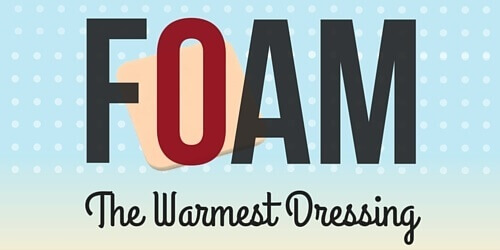Keeping a wound warm is an important part of wound care treatment, and foam dressing does the trick because it effectively maintains optimum temperatures and promotes healing.
For wound care clinicians – and anyone else who ever treats wounds – it’s important to know that moist wounds heal faster. However, moisture on any surface (including wounds) will begin evaporating when exposed to air, and at a quicker rate as the surface cools. So the challenge of healing wounds effectively is to keep a wound moist and warm. Fortunately, foam dressings maintain optimum healing conditions, and help our patients heal faster.
Why warm is better
As wound tissues lose moisture, a cooling effect occurs in the wound. Because cells and enzymes function optimally at normal body temperature, a drop of just 2 °C is sufficient enough to negatively affect the biological healing process.
In fact, when a wound dressing is changed, it can take a wound base temperature up to four hours before it returns to normal. This is an important factor to consider when anticipating healing times, as well as when prepping your patient for a dressing change. Additionally, when tissue cooling occurs, it can lead to a higher risk of infection due to vasoconstriction, and hemoglobin’s increased need for oxygen. This, in turn, decreases the amount of oxygen available for neutrophils, which fight infection.
So how does this all tie in to dressings? By using the right type of dressings – and applying them properly – you can create an optimum environment for wound healing. The dressing that keeps the wound bed the warmest is foam.
Foam Dressing
Semipermeable polyurethane foam dressing is nonadherent and nonlinting. It has a hydrophobic or waterproof outer layer, and provides a moist wound environment. Other characteristics of foam dressing include:
- It is permeable to water vapor, but blocks the entry of bacteria and contaminants
- It can be purchased in various thicknesses, with or without adhesive border
- It is available in pads, sheets, and cavity dressings
Consider using foam as primary or secondary dressing for partial- and full-thickness wounds, with minimal to heavy drainage. In addition, foam dressing:
- Works well for granulating and epithelializing wounds
- Provides insulation to keep wounds warm
- As secondary dressing for wounds with packing
- Can be used to absorb drainage around tubes
- Helpful for hypergranulation tissue along with compression
The advantages to using foam dressing on wounds are that it:
- Provides moist wound healing
- Doesn’t adhere to the wound
- Provides cushioning
- Is easy to apply and remove
- Can be used with infected wounds
- Provides a bacterial barrier
- Is effective with hypergranulation
- Can be used under compression
- Can be cut to accommodate tubes
The disadvantages to using foam dressing on wounds include:
- It could be expensive if exudate requires daily dressing changes
- Wound beds may desiccate if there is no exudate from the wound
- A secondary dressing might be required
- If it becomes saturated, it can lead to maceration of the periwound
- It is contraindicated for use with third-degree burns, dry eschar, and sinus tracts
What do you think?
Knowing that moist and warm wounds heal faster obviously makes using the right dressings (and applying them properly) crucial to effective wound care. Do you regularly use foam dressings, and have you noticed a difference in healing time? And have you learned any special application techniques that help keep wounds at an optimum body temperature? We’d love to hear about your experiences – please leave your comments below.
Wound Care Education Institute® provides online and onsite courses in the fields of Skin, Wound, Diabetic and Ostomy Management. Health care professionals who meet the eligibility requirements may sit for the prestigious WCC®, DWC® and OMS national board certification examinations through the National Alliance of Wound Care and Ostomy® (NAWCO®). For more information see wcei.net.
What do you think?

